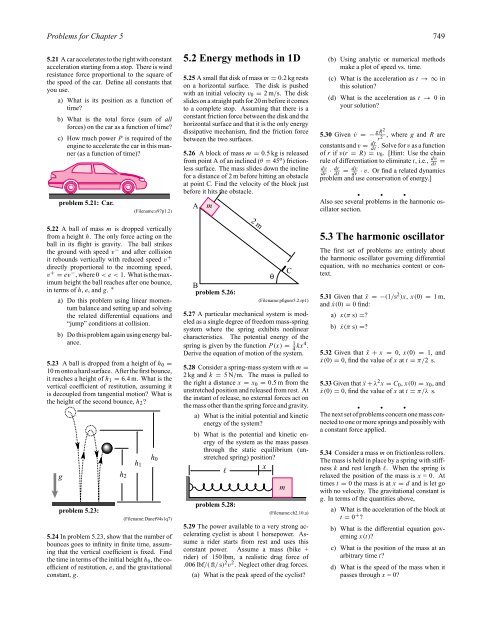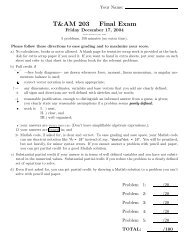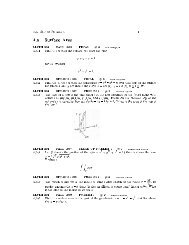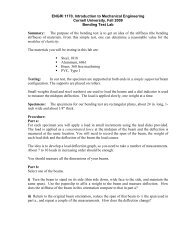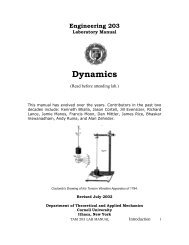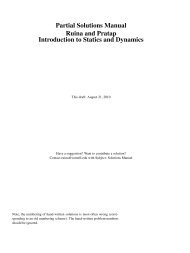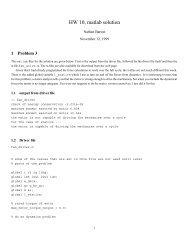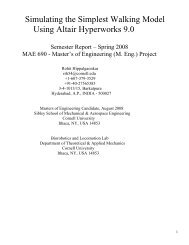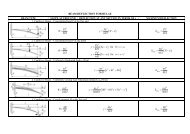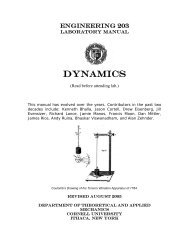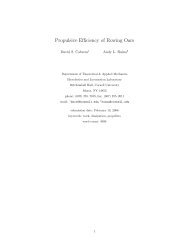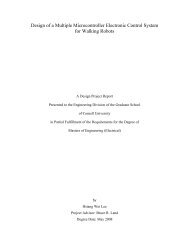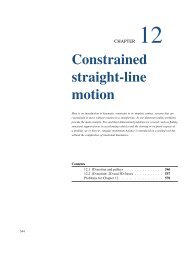Introduction to and Andy Ruina and Rudra Pratap
Introduction to and Andy Ruina and Rudra Pratap
Introduction to and Andy Ruina and Rudra Pratap
- No tags were found...
You also want an ePaper? Increase the reach of your titles
YUMPU automatically turns print PDFs into web optimized ePapers that Google loves.
Problems for Chapter 5 7495.21 A car accelerates <strong>to</strong> the right with constantacceleration starting from a s<strong>to</strong>p. There is windresistance force proportional <strong>to</strong> the square ofthe speed of the car. Define all constants thatyou use.a) What is its position as a function oftime?b) What is the <strong>to</strong>tal force (sum of allforces) on the car as a function of time?c) How much power P is required of theengine <strong>to</strong> accelerate the car in this manner(as a function of time)?problem 5.21: Car.(Filename:s97p1.2)5.22 A ball of mass m is dropped verticallyfrom a height h. The only force acting on theball in its flight is gravity. The ball strikesthe ground with speed v − <strong>and</strong> after collisionit rebounds vertically with reduced speed v +directly proportional <strong>to</strong> the incoming speed,v + = ev − , where 0 < e < 1. What is the maximumheight the ball reaches after one bounce,in terms of h, e, <strong>and</strong> g. ∗a) Do this problem using linear momentumbalance <strong>and</strong> setting up <strong>and</strong> solvingthe related differential equations <strong>and</strong>“jump” conditions at collision.b) Do this problem again using energy balance.5.23 A ball is dropped from a height of h 0 =10 m on<strong>to</strong> a hard surface. After the first bounce,it reaches a height of h 1 = 6.4 m. What is thevertical coefficient of restitution, assuming itis decoupled from tangential motion? What isthe height of the second bounce, h 2 ?gproblem 5.23:h 2h 1h 0(Filename:Danef94s1q7)5.24 In problem 5.23, show that the number ofbounces goes <strong>to</strong> infinity in finite time, assumingthat the vertical coefficient is fixed. Findthe time in terms of the initial height h 0 , the coefficien<strong>to</strong>f restitution, e, <strong>and</strong> the gravitationalconstant, g.5.2 Energy methods in 1D5.25 A small flat disk of mass m = 0.2 kg restson a horizontal surface. The disk is pushedwith an initial velocity v 0 = 2m/s. The diskslides on a straight path for 20 m before it comes<strong>to</strong> a complete s<strong>to</strong>p. Assuming that there is aconstant friction force between the disk <strong>and</strong> thehorizontal surface <strong>and</strong> that it is the only energydissipative mechanism, find the friction forcebetween the two surfaces.5.26 A block of mass m = 0.5 kg is releasedfrom point A of an inclined (θ = 45 o ) frictionlesssurface. The mass slides down the inclinefor a distance of 2 m before hitting an obstacleat point C. Find the velocity of the block justbefore it hits the obstacle.AmBproblem 5.26:2 mθC(Filename:pfigure5.2.rp1)5.27 A particular mechanical system is modeledas a single degree of freedom mass-springsystem where the spring exhibits nonlinearcharacteristics. The potential energy of thespring is given by the function P(x) = 1 4 kx4 .Derive the equation of motion of the system.5.28 Consider a spring-mass system with m =2 kg <strong>and</strong> k = 5N/m. The mass is pulled <strong>to</strong>the right a distance x = x 0 = 0.5 m from theunstretched position <strong>and</strong> released from rest. Atthe instant of release, no external forces act onthe mass other than the spring force <strong>and</strong> gravity.a) What is the initial potential <strong>and</strong> kineticenergy of the system?b) What is the potential <strong>and</strong> kinetic energyof the system as the mass passesthrough the static equilibrium (unstretchedspring) position?xlproblem 5.28:m(Filename:ch2.10.a)5.29 The power available <strong>to</strong> a very strong acceleratingcyclist is about 1 horsepower. Assumea rider starts from rest <strong>and</strong> uses thisconstant power. Assume a mass (bike +rider) of 150 lbm, a realistic drag force of.006 lbf/( ft/ s) 2 v 2 . Neglect other drag forces.(a) What is the peak speed of the cyclist?(b) Using analytic or numerical methodsmake a plot of speed vs. time.(c) What is the acceleration as t →∞inthis solution?(d) What is the acceleration as t → 0inyour solution?5.30 Given ˙v = − gR2r 2 , where g <strong>and</strong> R areconstants <strong>and</strong> v = drdt . Solve for v as a functionof r if v(r = R) = v 0 . [Hint: Use the chainrule of differentiation <strong>to</strong> eliminate t, i.e., dvdt =dvdr · drdt = dvdr · v. Orfind a related dynamicsproblem <strong>and</strong> use conservation of energy.]• • •Also see several problems in the harmonic oscilla<strong>to</strong>rsection.5.3 The harmonic oscilla<strong>to</strong>rThe first set of problems are entirely aboutthe harmonic oscilla<strong>to</strong>r governing differentialequation, with no mechanics content or context.5.31 Given that ẍ =−(1/s 2 )x, x(0) = 1m,<strong>and</strong> ẋ(0) = 0 find:a) x(π s) =?b) ẋ(π s) =?5.32 Given that ẍ + x = 0, x(0) = 1, <strong>and</strong>ẋ(0) = 0, find the value of x at t = π/2 s.5.33 Given that ẍ + λ 2 x = C 0 , x(0) = x 0 , <strong>and</strong>ẋ(0) = 0, find the value of x at t = π/λ s.• • •The next set of problems concern one mass connected<strong>to</strong> one or more springs <strong>and</strong> possibly witha constant force applied.5.34 Consider a mass m on frictionless rollers.The mass is held in place by a spring with stiffnessk <strong>and</strong> rest length l. When the spring isrelaxed the position of the mass is x =0. Attimes t = 0 the mass is at x = d <strong>and</strong> is let gowith no velocity. The gravitational constant isg. In terms of the quantities above,a) What is the acceleration of the block att = 0 + ?b) What is the differential equation governingx(t)?c) What is the position of the mass at anarbitrary time t?d) What is the speed of the mass when itpasses through x =0?


